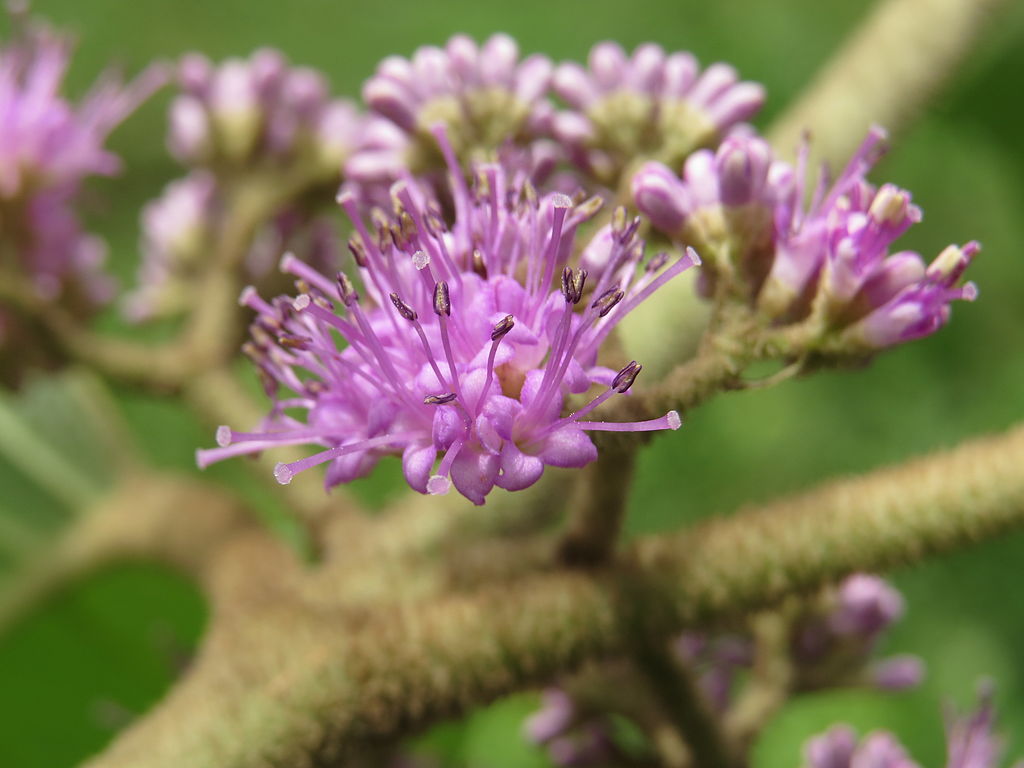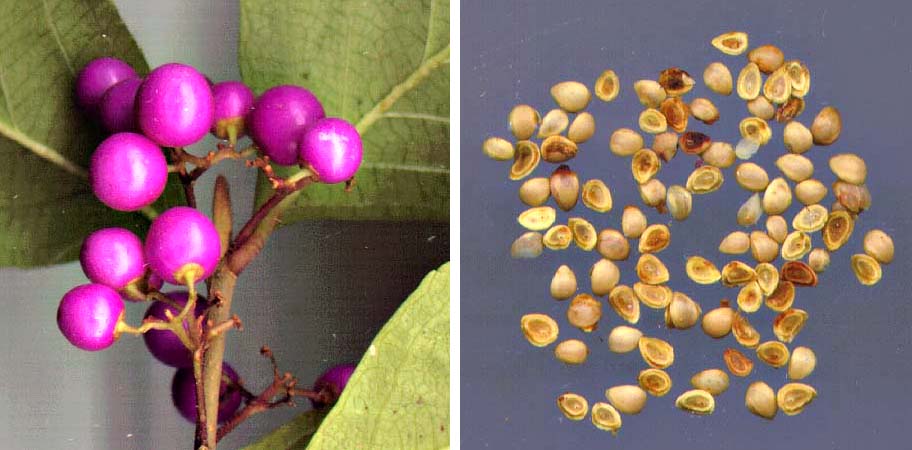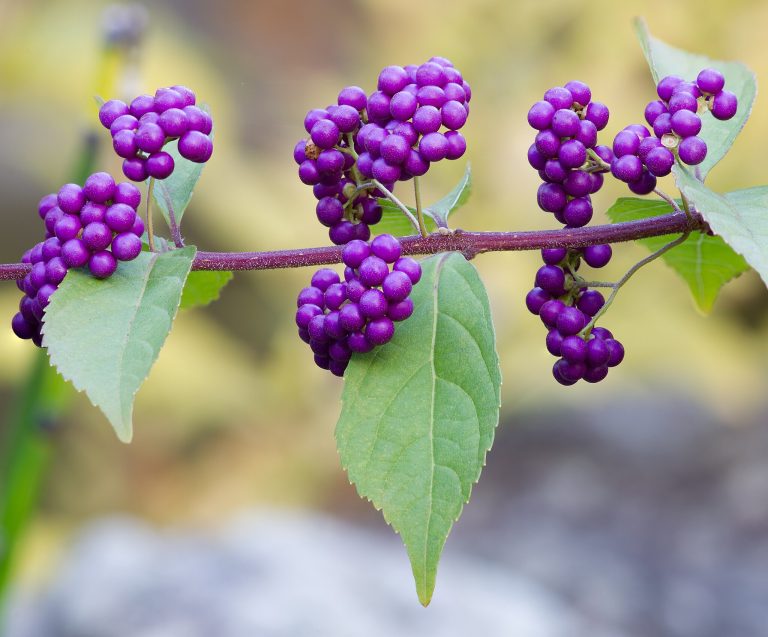In both the East and the West, before modern medicine there were herbs. People, mainly women, knew their plants and understood their medicinal effects. Valuable recipes were recorded in books or passed along orally through generations. Basic health care was relatively reliable and accessible, with most households having a store of prepared remedies on hand.
In this series, as we go through the herbal alphabet exploring easy-to-grow plants that have a history in traditional medicine, we find a winning specimen for “B.” Beautyberry is not only a powerful plant for healing, it is also stunningly beautiful.
Beautyberry, the plant
Beautyberry (Callicarpa Americana) is a deciduous shrub native to the southeastern United States. For centuries, native Americans made use of the plant and its purple berries to treat various conditions. The fruit can also be cooked into tasty preserves. Other species of Callicarpa are found in Central America and Asia, where they are likewise used for medicinal purposes.

The plants average between three and six feet in height, but can grow as tall as 10 feet. Their multi-stemmed branches host inconspicuous, pinkish flowers in July, which attract butterflies and bees. Jewel-like magenta or purple berries appear in September and hold for a couple months before shriveling. Both the fresh and shriveled berries are enjoyed by numerous birds and mammals.
Masses of beautyberry are found growing naturally in the understory of southern hardwood forests, where there is plenty of leaf mould. The appealing plant has also made it into landscapes as an ornamental specimen as far north as New Jersey, USDA plant hardiness zones six and seven.
Traditional use of beautyberry
Success
You are now signed up for our newsletter
Success
Check your email to complete sign up
Native American tribes from the southeastern United States used every part of the beautyberry plant for various medicinal purposes, including aches, cholic, fever, menstrual problems, pain relief, swelling and ulcers.
To treat fevers, rheumatism or arthritis, tea made from the root and leaves was used in sweat baths. Root tea was also consumed to treat digestive issues. Bark from both the stem and root was applied to relieve itchy skin and irritation from bug bites. The berries were taken orally for many common complaints.
In Nigeria, Callicarpa is a traditional remedy for treating malaria and fever.
Medicinal properties of beautyberry
Modern research has revealed that beautyberry leaves, bark and berries possess potent compounds with promising medicinal value, including powerful antioxidants and analgesic compounds. The Journal of Ethnopharmacology published a study indicating that beautyberry contains antibacterial compounds capable of fighting E.coli and Staphylococcus aureus.
The plant also has anti-inflammatory properties suitable for reducing the pain, discomfort and swelling experienced with many conditions.
USDA researchers found that extracts from the leaves had results comparable to the common insect repellent DEET for repelling mosquitoes. Callicarpenal and intermedeol, compounds found in the leaves, also proved to be 100 percent effective against ticks. In 2008, researchers including Charles Cantrell and Jerome Klun reported that fire ants are also repelled by terpenoids in the leaves’ essential oil.
How to grow beautyberry

If you live outside the native range of beautyberries, but within the USDA hardiness zones 6-10, beautyberries may make a useful and attractive addition to your garden.
The plant is low maintenance and easy to grow in full sun to partial shade. Beautyberry bushes prefer rich soil with good drainage and neutral to slightly acidic pH, but are tolerant of many soils. Water regularly to establish, and then during stretches of hot, dry weather. Over-fertilizing can decrease fruit production. The branches may be pruned back in the winter to within one foot of the base.
If you can’t find plants at a nearby nursery, you can order them online, or start your own plants from seeds or cuttings — yet this requires some patience.
Starting beautyberry from cuttings
If you know someone with a beautyberry bush, they can be propagated from softwood cuttings. Simply take six inch cuttings from new growth, remove the leaves from the lower half, and dip that end into a rooting hormone (or one of several natural alternatives).
Poke the treated stems into small pots of moist, soilless, potting mix. Cover the whole pot with a large jar or glass bowl, or seal it in a clear plastic bag for a moisture-retaining greenhouse effect. Place the cuttings in bright, indirect sunlight, and wait.
After several weeks or up to three months, the successful cuttings will have grown new leaves, indicating that roots have formed as well. These are ready to transplant into the garden. Consider the plant’s sprawling habit and give them at least three feet spacing.

Starting beautyberry from seed
Germination can be sporadic, so obtaining plenty of seeds will improve your odds. Most packaged seeds will include a generous amount, or you can collect them from a living plant. To do this, take very ripe berries and allow them to dry completely before storing them in a cool, dark place.
Shortly before spring, pre-soak the seeds in cool water for 24 hours. In small pots or a seedling tray filled with moist starting mix, place seeds about one inch apart, and cover them lightly with soil.
Place the pots in bright, indirect sun and maintain even moisture. After germination (up to three months) cut the weaker seedlings off to give the stronger plants room to grow without disturbing their roots. When the roots are visible at the bottom of the pots, they are ready to transplant in the garden.
Home remedies with beautyberry
If you’ve gone to the trouble of establishing your own source of beautyberry, you’ll want to know how to use it. The plant can be used safely both internally and externally, providing you are not allergic to members of the Lamiaceae, or mint family — in which case you may have a reaction to beautyberry as well. The following methods of preparation can be used for a variety of conditions.
Beautyberry infusion
Leaves or berries steeped in hot water for 10-15 minutes will make an infusion suitable for sipping. Additional steeping time or simmering will yield a stronger infusion good for topical washes.

Beautyberry tincture
A tincture is a preserved medicine made by infusing alcohol with the herb. Finely chopped leaves or crushed berries can be mixed with vodka or brandy in a small jar. Shake the mixture every few days for several weeks, then strain the finished tincture into an amber bottle for storage.
Tinctures can remain effective for a year or more. They are taken orally in drops — straight or diluted in another liquid.
Beautyberry poultice
A poultice of crushed fresh leaves or berries can be placed on the affected area and held in place with a cloth bandage. A mini poultice for insect bites could be as simple as chewing a bit of leaf and pasting it to the bite with a bandaid.
Depending on the condition, remove or replace the poultice after about a half an hour.
Beautyberry salve
Salves are a preserved medicine for topical use. For a quick and basic recipe: warm ½ cup dried leaves or berries in 1 cup olive oil in a double boiler or crock pot for several hours on low. Strain out the herb and add 3 Tbsp beeswax pastilles. Stir until the wax completely melted. Remove from heat and add several drops of essential oil (rosemary is good for preservation).
Pour into clean 2 or 4 oz. jars. Salves will remain effective for about a year if stored in a cool, dark place. They are suitable for relieving many skin conditions.
Applications for beautyberry
Perhaps the simplest and most practical use of beautyberry is as an immediate, natural insect repellent. Crushed fresh leaves can be rubbed onto the skin to keep biting insects at bay.
For digestive issues, fever and infections, it is usually taken as a tea or tincture. These can also be effective against toothaches and other bodily discomfort, although poultices and salves are commonly used to treat inflammatory conditions of the joints and muscles — including arthritis and rheumatism.

However it is applied, treat this potent plant with respect. It should be used in moderation to avoid unpleasant side effects such as nausea, and with caution if you have experienced allergic reactions to other members of the mint family. It is advised to avoid the use of beautyberry during pregnancy or breastfeeding.
















